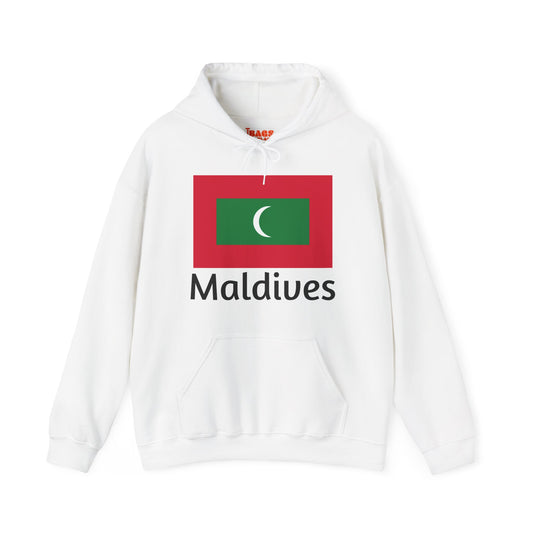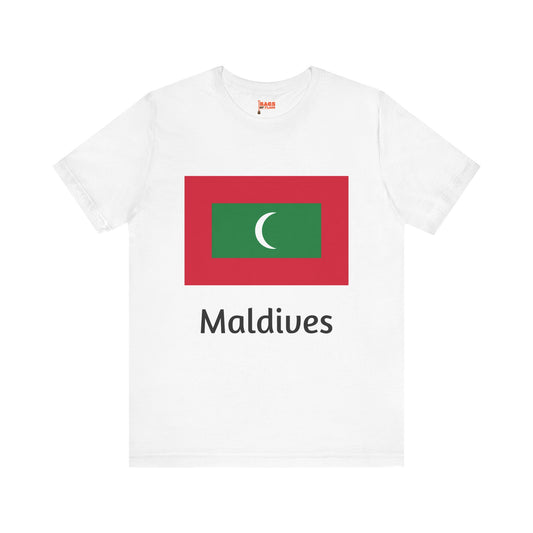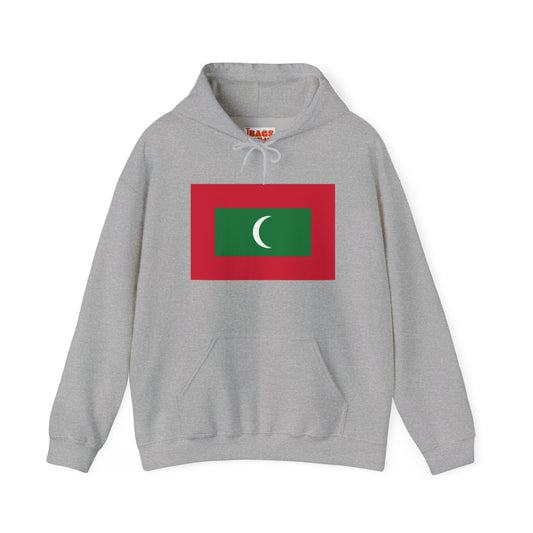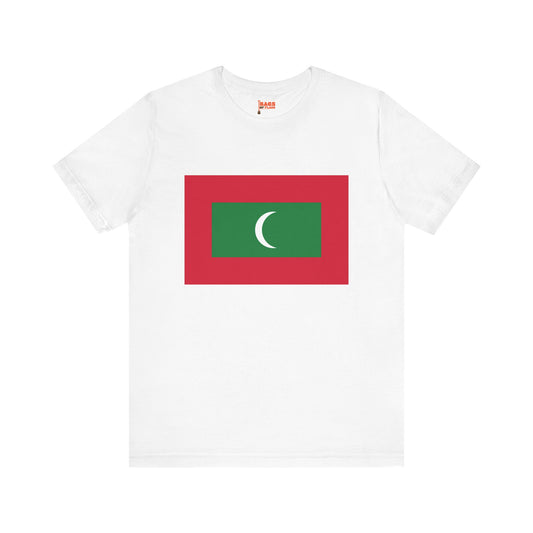-
Maldives Hoodies
Regular price $34.40 USDRegular priceUnit price / per -
Maldives T-shirts
Regular price $22.79 USDRegular priceUnit price / per -
Maldives Flag on Hoodies
Regular price $34.40 USDRegular priceUnit price / per -
Maldives Flag on T-shirt
Regular price $22.79 USDRegular priceUnit price / per
Collection: Maldives
The Maldives flag, also known as the flag of Maldives, is a symbol of national pride and identity for the people of this island nation. With its unique design and vibrant colors, the flag holds a significant place in the hearts of Maldivians. We will explore the various aspects of the Maldives flag, from its design and historical context to its symbolism and current relevance.
Overview of the Maldives Flag

The flag of Maldives is a distinctive and meaningful representation of the nation’s identity, characterized by:
- Red, which dominates the flag's backdrop, symbolizes the Maldivian people's courage and sacrifices.
- Green, forming a rectangle in the center, denotes peace, prosperity, and the lushness of the country's landscapes.
- White, used for the crescent moon and the five-pointed star within the green rectangle, stands for purity and the Islamic faith.
-
Design Elements:
- A broad red field encompassing the entire flag is a canvas for the central emblem.
- The green rectangle, positioned towards the hoist side, is emblematic of the country's focus on peace and progress.
- A white crescent moon aligns the nation with the Islamic world.
- Including a five-pointed star signifies the unity of the Maldives' administrative divisions under one national identity.
This combination of colors and symbols is visually striking and rich in meaning, encapsulating the essence of Maldivian sovereignty, religious adherence, and communal harmony.
Historical Context of the Maldives Flag
The journey to the current design of the Maldives flag, adopted on July 25, 1965, is marked by significant historical transitions reflecting the nation's quest for identity and sovereignty. Before its independence, the Maldives witnessed several variations of the flag, each symbolizing different eras and colonial influences. The evolution of the flag's design mirrors the changing political landscapes, from sultanate rule to British protection and eventually to an independent republic.
The 1965 adoption marked a pivotal moment, celebrating the end of British protection and the beginning of a new era as a sovereign state. This transition solidified the Maldives' status on the world stage and reinstated the importance of Islamic values and unity among its islands, as emphasized by the flag's symbols. The flag's evolution is a testament to the resilience and enduring spirit of the Maldivian people, who have navigated through periods of change to establish a symbol representing their nation's identity, beliefs, and aspirations.
Symbolism Behind the Maldives Flag

The flag of the Maldives is replete with symbolism that reflects the nation's core values, religious beliefs, and environment. The red field embodies the resilience and courage of the Maldivians, a tribute to those who have fought for the country's sovereignty and freedom. This color serves as a reminder of the sacrifices made by the people to defend their land.
The green rectangle is central to the flag's design, an emblem of the Maldives' dedication to peace and its rich natural beauty. The color green also hints at the country's prosperity, a nod to the lush vegetation that adorns the islands and the fertile promise of the land.
Dominating the green space, the white crescent moon symbolizes the Maldives' Islamic faith, a unifying religious identity shared amongst its citizens. This crescent is a familiar emblem in the Islamic world, signifying the nation's connection to a broader community of Muslim countries.
Lastly, the solitary white star with five points is emblematic of the unity and harmony within the Maldives. Each point represents one of the country's administrative divisions, illustrating the cohesive bond that ties the nation together. This star, set against the backdrop of green and red, accentuates the Maldives' commitment to unity, faith, and environmental stewardship, forming a profound statement of national identity and collective aspiration.
Current Relevance of the Maldives Flag
Today, the flag of Maldives plays a central role in the nation's life, prominently featured on a wide array of significant occasions. From marking the celebration of Independence Day to its presence at military commemorations, the flag symbolizes unity and national pride. Its use extends beyond solemn national ceremonies; it also adorns public buildings, educational institutions, and events that highlight the cultural heritage and achievements of the Maldives.
In the international arena, the Maldives flag represents the country at diplomatic events, sports competitions, and other global contexts, showcasing the nation's identity and values on the world stage. However, it has not been without its controversies, sparking dialogue and debate among the population regarding its symbols and the ideals they represent. Such discussions reflect the dynamic nature of national identity and the role symbols like the flag play in representing the evolving aspirations and values of the people.
Additional Facts and Unique Protocols
When displaying the Maldives flag, a specific protocol dictates that the green rectangle must face the pole side, ensuring the correct representation of the nation's emblem, especially when hung in a vertical orientation. This practice is a mark of respect and an adherence to the symbolism ingrained in the flag's design. In times of sorrow or national loss, the flag is traditionally lowered to half-mast, a poignant gesture of mourning that unites the country in its grief. This act signifies not only respect for the deceased but also the collective somberness of the Maldivian people during periods of mourning.
In the arena of international sports and competitions, the Maldives flag is a beacon of national pride, hoisted high to signify the country's participation and unity on the global stage. Athletes and representatives carry the flag, instilling a sense of patriotism and belonging among the Maldivian people, regardless of the event's location. The vibrant colors and symbols of the flag have also found their way into the hearts of Maldivian artists and designers, serving as a muse for a wide array of creative works. From paintings and sculptures to fashion and digital art, the flag's influence permeates various facets of Maldivian cultural expression, showcasing the deep connection between the nation's identity and its artistic endeavors. These practices and the flag's omnipresence in both national and international contexts underscore its significance as a symbol of Maldivian sovereignty, unity, and pride.








